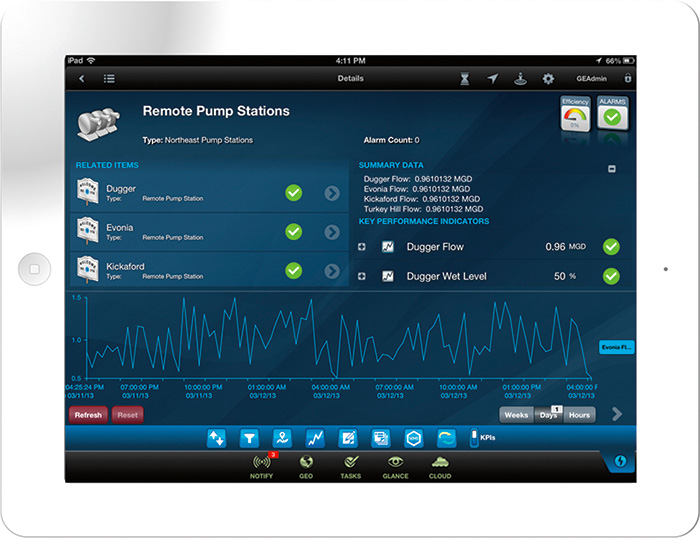A large portion of the pipes, pumps, valves and other water infrastructure operating in the U.S. today dates back to the 1940s or earlier. With water systems crumbling, the U.S. loses about 7 billion gallons of treated water per year through water main breaks and leaking pipes, at a time when almost a third of the nation’s cities are expected to experience a water scarcity crisis in the next few years.
Water main breaks can cost utilities millions annually and threaten public health and property. For years, however, water professionals have lived with this reality because, as the Water Innovations Alliance estimates, replacing the existing water infrastructure would cost almost $400 billion nationally.
The solution is straightforward: optimize the operation of the existing infrastructure with the instrumentation, controls and software technology that have been developed since the infrastructure was first installed. Then, with a greater understanding of the system, replace and/or rehabilitate that equipment when the optimization and analysis justifies it.
The Current Solution—Business as Usual
The solution that many water operations have adopted is largely based on a business-as-usual approach. Without intelligent instrumentation, control and software components in use to systematically analyze and identify potential problems, such as operational and capacity deficiencies, utilities are choosing to replace pumps, valves and other infrastructure by using only basic criteria such as age and material alone (regardless of whether it needs to be replaced).
More often than not, an older asset will need to be replaced before a newer one, but that is not always the case.
Choosing to approach the problem in an uninformed manner can mean continued operational inefficiencies and the ineffective use of the already scarce funding resources afforded to managers.
However, many water officials are apprehensive to invest in a more advanced system because they perceive it as complex, expensive and risky.
The reality is that by integrating system instrumentation and controls with intelligent software, water operators can ensure consistent, efficient and accountable operations while lowering costs, increasing regulatory compliance and enhancing future capital infrastructure planning.

Instrumentation paired with software and real-time operational intelligence can unlock value in data for operators.
Optimizing with Instrumentation, Controls
and Software
Even the oldest water infrastructure can be operationally enhanced with the strategic installation of instrumentation, controls and software that monitor the key system performance indicators (KPIs). KPIs provide a better understanding of the system as a whole and allow for more informed decision making.
In a sewer collection system, for instance, an operator may need to manage a number of pumping stations, but he is not able to fully understand their operations without the real-time and historized data that these assets could provide if they were equipped with integrated instrumentation, controls and software to analyze and optimize operations. Older equipment may not have the same inherent ability to automatically produce the type of information that newer, more advanced equipment has, but they can often be outfitted to provide much of it without having to be replaced.
By optimizing existing infrastructure, end users can extend the life of an asset for a few thousand dollars, as opposed to spending hundreds, or millions, to replace it because it has met an age or material criteria threshold. Real-time KPIs can give water operators essential components of data that can tell them:
- The stations that are not pumping at capacity
- The pumps that are drawing more power than needed
- The areas of the system that may have low chlorine residual
Over time, historical asset information combined with current data can indicate that an asset has reached the end of its useful service life, saving the utility continual repair and maintenance costs. It can also be used to prioritize critical asset replacement to achieve optimal system performance and reliability.
Real-Time Operational Intelligence
Speaking the language of assets by having them produce simple data elements that translate into a few KPIs is an important first step. However, it is not a standalone solution for better monitoring. If information from every pumping station in a system is simply being historized, operators will be overloaded with data and may not realize when these data indicate a possible catastrophic asset failure. The goal is to shift the operational culture from one of forensic analysis of what happened after the fact, to being informed of impending asset or system failure before it happens in real time.
With a software solution in place that offers mobile, real-time operational intelligence (RtOI), a manager can know which assets are performing within specification or which ones need attention at any moment. This information is available from any location using a smart device such as an Apple iPad, based on a few KPIs and not terabytes of data.
A field operator armed with even this simple level of information could then be immediately dispatched to solve the problem based on the equipment’s geo-location. This is especially helpful in the event of an emergency to address an issue quickly—or even before it happens—rather than after significant damage has been done.
The operator will not only know which asset needs immediate attention, but will also receive the alerts and notifications necessary to understand which component has malfunctioned upon arrival. This capability allows operators to be proactive, instead of reactive, with their operations.
Today, the reason associated with anything that goes wrong is primarily a function of the assets’ age, material and operational condition. The strategic integration of instrumentation, controls and software allows managers to monitor operations through the lens of real-time operational intelligence.
In turn, by using KPIs displayed on a simple, secure app built for consumer devices, these managers are able to optimize the operations of existing assets. The can also prioritize equipment replacement based on intelligent metrics, instead of age or other basic criteria.

